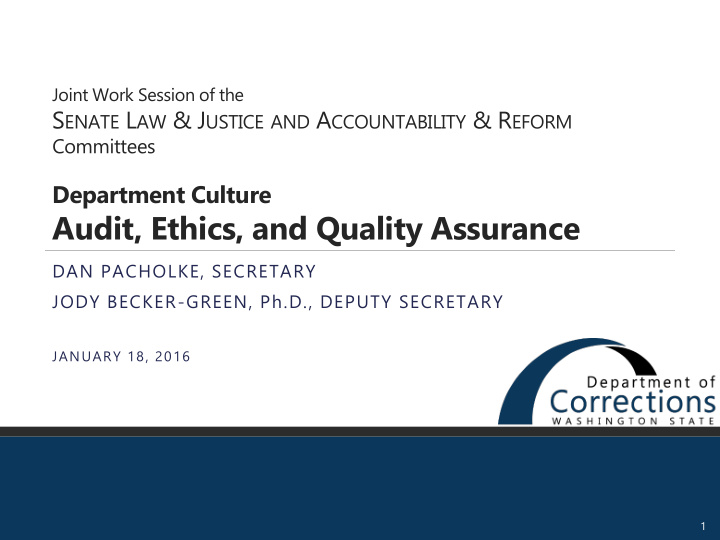



Joint Work Session of the S ENATE L AW & J USTICE AND A CCOUNTABILITY & R EFORM Committees Department Culture Audit, Ethics, and Quality Assurance DAN PACHOLKE, SECRETARY JODY BECKER-GREEN, Ph.D., DEPUTY SECRETARY JANUARY 18, 2016 1
Culture in the Department of Corrections DOC has 8,200 employees focused on public safety. We are responsible for over 17,000 incarcerated offenders and 17,000 offenders on supervision. We are a response-oriented criminal justice agency; largely located in the field, in prisons and community corrections across the state We are also a social services agency; focused on case management, health services, and offender change We continually improve and evolve our work based on research, innovation, and emerging best practices We provide services to victims, offenders, and their families We are accountable to the citizens of Washington state 2
External Accountability Washington State Auditor’s Office Performance, Financial Audits, and Whistleblower Information Technology Security and OCIO policies Federal Prison Rape Elimination Act (PREA) compliance National Incident Command System (ICS) compliance State and Local Fire and Life Safety Inspections Mutual Aid exercises (full hazard and full scale) Labor and Industries Safety Inspections Department of Health Medical, hospital, dental, and pharmacy Food Services and Manufacturing 3
Internal Accountability Efforts Internal Audits Ethics Operational reviews Whistleblower Safety Audits Quality Assurance Evidence-based offender programs Ensuring fidelity of the program and quality of the delivery Correctional records Data accuracy and completeness Special team readiness Emergency response audits Critical Incident Reviews 4
Other Accountability Programs For Offenders Grievance program Appeal processes for hearings and other policies For Offender Families State and local family councils For Labor Regular labor management meetings Adherence to collective bargaining agreements For Employees Human Resource grievance programs Place Safety Musters Statewide and Local Security Advisory Committees Employee Engagement Survey 5
Washington State Employee Engagement Survey 84% of DOC staff responded to the 2015 statewide employee engagement survey. A 46% increase from 2014. 2015 Positive Question 2014 Difference Responses I know what is expected of me at work 84% 83% p 1% My supervisor treats me with dignity and 81% 78% p 3% respect My agency consistently demonstrates 69% 67% p 2% support for a diverse workforce I know how my work contributes to the 69% 68% p 1% goals of the agency My supervisor gives me ongoing feedback 62% 56% p 6% that helps me improve my performance I know how my agency measures its success 43% 36% p 7% In general, I’m satisfied with my job 64% 61% p 3% 6
Joint Work Session of the S ENATE L AW & J USTICE AND A CCOUNTABILITY & R EFORM Committees OMNI Quality Control Processes DAN PACHOLKE, SECRETARY IRA FEUER, MBA, CHIEF INFORMATION OFFICER JANUARY 18, 2016 7
OMNI Release Process 8
OMNI Quality Assurance (Testing) DOC follows IT best practices for testing of software Unit Testing – tests a specific function of code performed by the programmer Integration Testing – tests software to verify the interfaces between components against a software design Component Interface Testing – checks the handling of data passed between various units, or subsystem components System testing – tests a completely integrated system to verify that it meets its requirements. Smoke testing – consists of minimal attempts to operate the software, designed to determine whether there are any basic problems that will prevent it from working at all. Such tests can be used as build verification testing. 9
OMNI Quality Assurance (Testing), cont. Regression testing – testing focuses on finding defects after a major code change has occurred. Specifically, it seeks to uncover software regressions, as degraded or lost features, including old bugs that have come back. User Acceptance testing – testing performed by the customer, often in a lab environment. Scenario testing – testing on known scenarios derived from the business requirements. Scenarios are manually calculated and then compared to the computer results. 10
Actions Taken IT Governance Implementing best practices from Office of the Chief Information Officer (OCIO) Increasing involvement of program and subject matter experts Creating systems to communicate outcomes to senior leadership IT Prioritization Working with OCIO to improve the IT prioritization process Using the Decision Lens program to prioritize defects, system enhancements, and projects Developing criteria for ranking of all projects; with an emphasis on public safety User Quality Assurance Spot-checking of the new code after release 11
Questions? 12
Recommend
More recommend